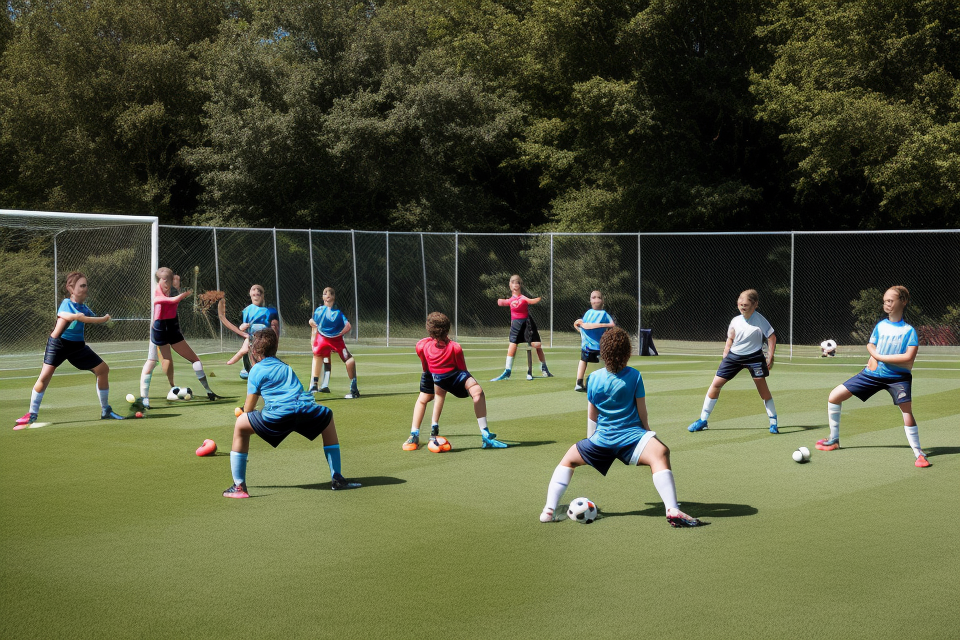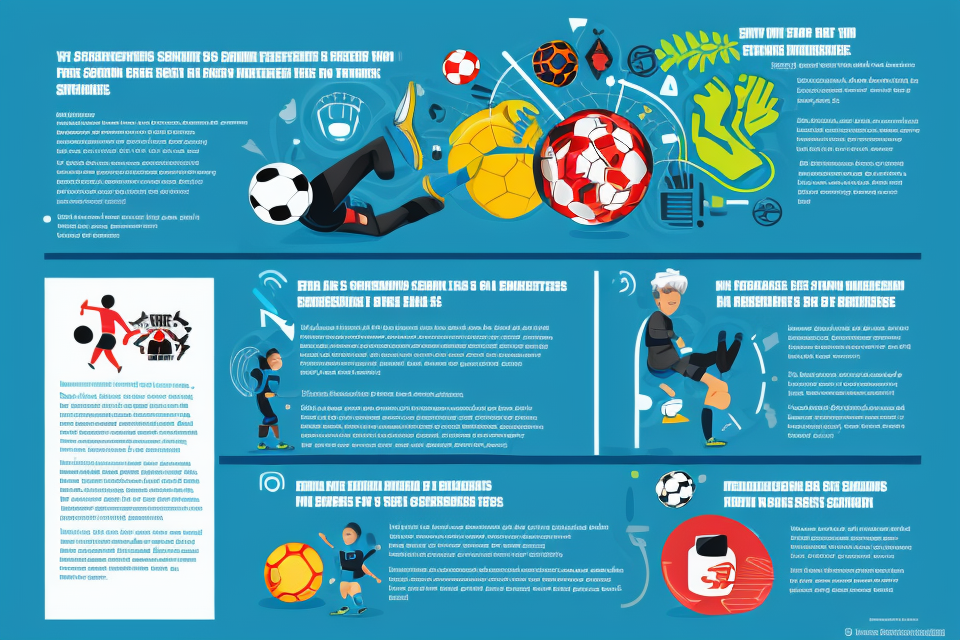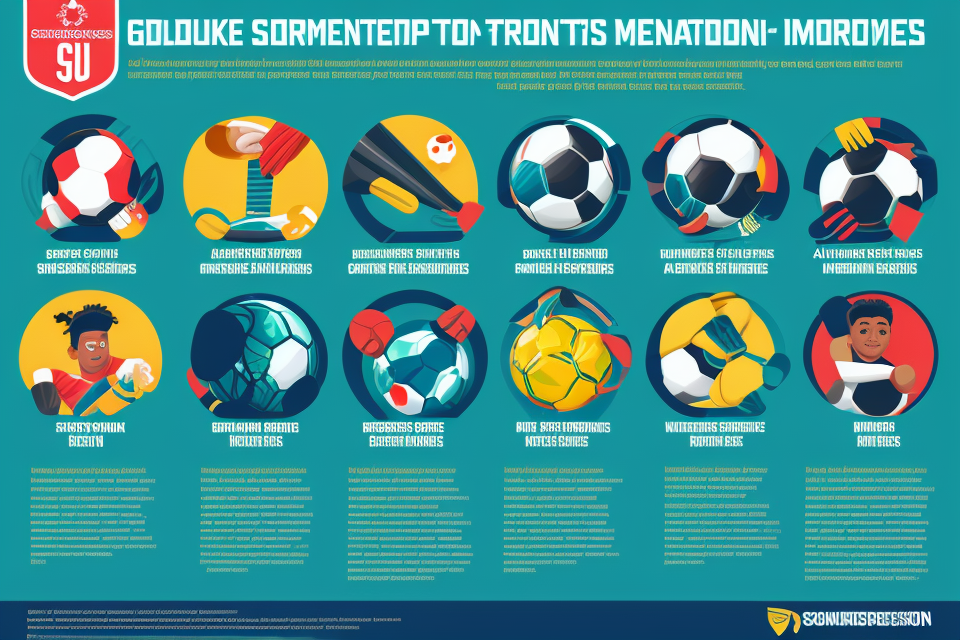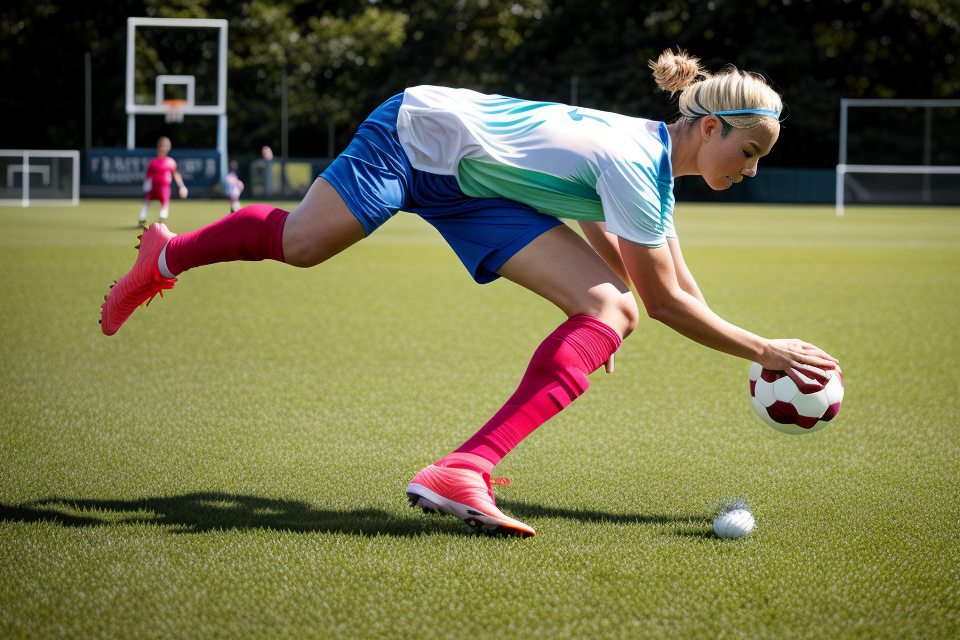Soccer is a beloved sport around the world, but it can also be a dangerous one. Injuries are an unfortunate part of the game, but they don’t have to be. Injury prevention in soccer is all about taking steps to reduce the risk of injury and keep players safe on the field. This comprehensive guide will cover everything you need to know about preventing injuries in soccer, from warm-up routines to proper technique and equipment. Whether you’re a player, coach, or parent, this guide has something for everyone. So lace up your cleats and get ready to learn how to stay safe and healthy on the soccer field.
Understanding Soccer Injuries
Common Types of Soccer Injuries
Soccer is a physically demanding sport that requires players to be in top condition to perform at their best. However, with the high level of competition and physicality involved in the game, injuries are an unfortunate but common occurrence. Understanding the most common types of soccer injuries can help players and coaches take preventative measures to reduce the risk of injury.
Muscle Strains
Muscle strains are one of the most common injuries in soccer. They occur when a muscle is stretched beyond its capacity, resulting in tears in the muscle fibers. These injuries can happen to any muscle in the body, but they are most common in the legs, particularly the hamstrings and calf muscles.
Ligament Sprains
Ligament sprains are another common injury in soccer. They occur when a ligament, which connects bones together, is stretched or torn. This can happen in various parts of the body, but the most common locations are the ankle and knee.
Concussions
Concussions are a type of injury that occurs when a blow to the head or body causes the brain to move rapidly back and forth. This can result in damage to the brain cells and cause a variety of symptoms, including headaches, dizziness, and memory loss. Concussions can occur in any contact sport, including soccer, and can have long-term effects if not properly treated.
Ankle Sprains
Ankle sprains are a common injury in soccer, particularly for players who make frequent cuts and changes of direction. They occur when the ligaments surrounding the ankle joint are stretched or torn, resulting in pain and swelling.
Knee Injuries
Knee injuries are also common in soccer, particularly for players who make sudden stops and changes of direction. These injuries can range from minor strains and sprains to more serious injuries such as ligament tears or cartilage damage. Proper training and injury prevention techniques can help reduce the risk of knee injuries in soccer.
Factors Contributing to Soccer Injuries
- Poor technique: One of the primary factors contributing to soccer injuries is poor technique. This can include incorrect methods of tackling, heading the ball, and changing direction rapidly. Players who do not use proper technique are more likely to suffer from injuries such as sprains, strains, and even concussions.
- Lack of proper warm-up and cool-down: Another contributing factor to soccer injuries is the lack of proper warm-up and cool-down. It is essential to prepare the body for physical activity by performing dynamic stretches and light exercise before starting a game or practice. Similarly, it is crucial to cool down after the activity to prevent muscle soreness and reduce the risk of injury.
- Insufficient strength and conditioning: Strength and conditioning are crucial for preventing soccer injuries. Weak muscles are more prone to injury, and players who do not engage in regular strength training are at a higher risk of suffering from muscle strains and other injuries. A well-rounded strength and conditioning program should include exercises that target the legs, core, and upper body.
- Inadequate equipment: Inadequate equipment can also contribute to soccer injuries. Players must wear appropriate footwear that provides support and protection for their feet and ankles. Additionally, shin guards are essential for preventing shin splints and other injuries to the lower legs. Finally, players should wear proper attire, such as comfortable shorts and a jersey, to avoid irritation and chafing.
- Overuse and fatigue: Overuse and fatigue are significant contributors to soccer injuries. Players who participate in multiple games or practices in a short period are at a higher risk of suffering from overuse injuries such as tendinitis or plantar fasciitis. It is essential to give the body time to rest and recover between games and practices to prevent overuse injuries.
Prevention Strategies for Soccer Injuries
Proper Warm-up and Cool-down
Proper warm-up and cool-down exercises are essential components of injury prevention in soccer. A comprehensive warm-up routine should be performed before every soccer game or practice, while a cool-down session should be conducted after each event. These activities are designed to prepare the body for physical activity, reduce the risk of injury, and promote recovery.
Stretching Exercises
Stretching exercises are an integral part of the warm-up routine. They help to increase the range of motion, improve flexibility, and enhance muscle elasticity. Players should focus on dynamic stretches that involve movement, such as leg swings, arm circles, and hip openers. These exercises help to prepare the muscles, tendons, and ligaments for the physical demands of soccer.
Dynamic Warm-up Drills
Dynamic warm-up drills are exercises that involve movement and simulate the physical actions of soccer. They are designed to increase blood flow, elevate heart rate, and raise the core temperature of the body. Examples of dynamic warm-up drills include light jogging, skipping, lunges, and jumping jacks. These exercises help to prepare the body for the physical demands of soccer and reduce the risk of injury.
Cool-down Activities
Cool-down activities are essential for restoring the body to its pre-exercise state. They help to reduce muscle soreness, prevent stiffness, and promote recovery. Players should engage in light exercise, such as walking or jogging, followed by static stretches that target the major muscle groups used in soccer, including the hamstrings, quadriceps, calves, and groin. These exercises help to improve flexibility, reduce muscle soreness, and prevent injury.
In summary, proper warm-up and cool-down exercises are critical components of injury prevention in soccer. Players should incorporate dynamic warm-up drills, stretching exercises, and cool-down activities into their pre- and post-match routines to prepare the body for physical activity, reduce the risk of injury, and promote recovery.
Strength and Conditioning
To prevent soccer injuries, strength and conditioning is an essential aspect that players and coaches should prioritize. By incorporating specific exercises, players can build their physical capabilities and reduce their risk of injury.
Focusing on Injury-Prone Areas
In soccer, certain areas of the body are more prone to injury than others. Players should focus on strengthening these areas to improve their overall durability and reduce their risk of injury. For example, the knee, ankle, and hamstring are common areas that players should focus on strengthening.
Incorporating Balance and Stability Exercises
Balance and stability are crucial in soccer, as players need to maintain their footing while running, changing direction, and making tackles. Incorporating exercises that improve balance and stability can help prevent injuries and improve overall performance. Examples of such exercises include single-leg squats, single-leg deadlifts, and balance boards.
Developing Explosiveness and Power
Soccer requires players to be explosive and powerful, especially when making tackles, shooting, and crossing the ball. Strength and conditioning exercises that develop explosiveness and power can help players perform at their best while reducing their risk of injury. Examples of such exercises include plyometrics, jumps, and weightlifting.
It is important to note that strength and conditioning exercises should be tailored to the individual player’s needs and goals. Players should work with a qualified strength and conditioning coach to develop a program that is specific to their needs and helps them achieve their goals while minimizing their risk of injury.
Equipment and Gear
Proper equipment and gear are essential for preventing soccer injuries. It is important to wear the right kind of shoes, shin guards, mouthguards, and other protective gear to reduce the risk of injury.
Appropriate Footwear
Choosing the right kind of shoes is crucial for preventing soccer injuries. Soccer shoes should have a firm grip on the ground and good traction to prevent slips and falls. The shoes should also provide adequate support for the foot and ankle to prevent ankle sprains and other injuries.
Shin Guards
Shin guards are essential protective gear for soccer players. They help prevent shin splints, stress fractures, and other injuries to the lower leg. Shin guards should fit snugly and be made of a durable material that can withstand the impact of a soccer game.
Mouthguards
Mouthguards are important protective gear for soccer players. They help prevent dental injuries, such as broken teeth and bruises to the lips and gums. Mouthguards should be custom-fitted and made of a durable material that can withstand the impact of a soccer game.
Other Protective Gear
Other protective gear for soccer players includes headgear, knee braces, and elbow pads. Headgear can help prevent head injuries, such as concussions, while knee braces and elbow pads can help prevent knee and elbow injuries. These protective gear should fit snugly and be made of a durable material that can withstand the impact of a soccer game.
Technique and Form
Proper technique and form are crucial in preventing soccer injuries. Here are some key points to keep in mind:
- Proper kicking and striking techniques: A correct kicking and striking technique can help prevent injuries to the knee, foot, and ankle. Players should focus on using their lower body to generate power and avoid using their upper body. They should also ensure that their non-kicking foot is pointed in the direction they want the ball to go.
- Correct landing and jumping techniques: Landing and jumping techniques are important in preventing injuries to the knee and ankle. Players should try to land on their dominant foot after jumping and avoid over-striding, which can put excessive stress on the knee. They should also avoid landing on their ankles, as this can cause sprains.
- Avoiding excessive head movement: Excessive head movement can lead to neck injuries, such as whiplash. Players should keep their head still while moving and avoid sudden movements. They should also wear proper protective gear, such as a soft collar or a neck brace, to reduce the risk of injury.
Overall, by focusing on proper technique and form, players can significantly reduce their risk of soccer injuries. It is important to remember that prevention is always better than treatment, and taking the time to learn and practice proper techniques can save players from a lot of pain and discomfort in the long run.
Player Education and Awareness
Understanding the Risks and Causes of Injuries
Educating players about the risks and causes of soccer injuries is crucial in preventing them. Understanding the mechanisms of injuries and how they occur can help players take necessary precautions to avoid them. Players should be aware of the most common types of soccer injuries, such as muscle strains, ligament sprains, and head injuries, and the factors that contribute to them, such as poor technique, lack of fitness, and insufficient warm-up.
Implementing Injury Prevention Programs
Injury prevention programs are designed to reduce the risk of injury in soccer players. These programs often include exercises to improve strength, flexibility, and balance, as well as techniques to prevent injuries such as proper warm-up and cool-down procedures, correct stretching techniques, and proper technique for tackling and jumping. Players should be encouraged to participate in these programs to reduce their risk of injury.
Promoting Communication and Open Dialogue about Injuries
Promoting communication and open dialogue about injuries is important in preventing them. Players should feel comfortable discussing any injuries or pain they may be experiencing with their coaches and teammates. This can help identify potential injuries early on and prevent them from becoming more severe. Coaches should also encourage players to report any injuries or pain, and provide them with the necessary resources and support to help them recover.
Implementing Injury Prevention Programs in Soccer
Developing a Comprehensive Approach
When developing an injury prevention program for soccer, it is important to take a comprehensive approach. This involves collaborating with coaches, trainers, and medical professionals to assess players’ strengths and weaknesses and incorporate injury prevention into training sessions.
Collaborating with coaches, trainers, and medical professionals
Collaboration among all parties involved in soccer is crucial to the success of an injury prevention program. Coaches, trainers, and medical professionals each bring unique perspectives and expertise to the table. By working together, they can create a cohesive approach to injury prevention that takes into account the specific needs of each player.
Assessing players’ strengths and weaknesses
Before implementing an injury prevention program, it is important to assess each player’s strengths and weaknesses. This can be done through a combination of physical testing, such as measuring flexibility and strength, and observational analysis, such as watching players during training and games.
By identifying areas of weakness, coaches and trainers can tailor injury prevention exercises to each player’s specific needs. For example, a player with poor hamstring flexibility may benefit from stretching exercises, while a player with weak core muscles may need exercises to strengthen their abdominal and back muscles.
Incorporating injury prevention into training sessions
Once players’ strengths and weaknesses have been assessed, injury prevention exercises can be incorporated into training sessions. These exercises should be specific to the needs of each player and should be integrated into warm-up and cool-down routines as well as into training drills.
It is important to ensure that injury prevention exercises are not overly time-consuming or cumbersome, as this can lead to player fatigue and resistance. Instead, they should be incorporated seamlessly into training sessions, with a focus on injury prevention rather than additional exercise.
Overall, a comprehensive approach to injury prevention in soccer involves collaboration among coaches, trainers, and medical professionals, assessment of players’ strengths and weaknesses, and incorporation of injury prevention exercises into training sessions. By taking a comprehensive approach, soccer teams can reduce the risk of injury and improve overall performance.
Injury Management and Rehabilitation
Recognizing signs of potential injuries
One of the most crucial aspects of injury management and rehabilitation in soccer is recognizing the signs of potential injuries. It is essential to be aware of the early warning signs of injuries to prevent them from becoming more severe. Some of the signs of potential injuries include:
- Pain or discomfort in a specific area of the body
- Swelling or inflammation
- Redness or heat in the affected area
- Limited range of motion or stiffness
- Weakness or fatigue in the affected area
It is essential to recognize these signs early on and take appropriate action to prevent the injury from worsening.
Encouraging early reporting of injuries
Another critical aspect of injury management and rehabilitation in soccer is encouraging players to report injuries early. Players may be hesitant to report injuries due to fear of being sidelined or losing their starting position. However, it is essential to create a culture of open communication and encourage players to report any injuries as soon as possible.
Early reporting of injuries allows for prompt treatment and intervention, which can prevent the injury from becoming more severe and prolonging the recovery process. It also helps to prevent the injury from worsening, which can lead to a more significant and prolonged period of time away from the game.
Implementing effective rehabilitation programs
Once an injury has been identified, it is essential to implement an effective rehabilitation program to help the player recover and return to full fitness. Rehabilitation programs should be tailored to the specific injury and the individual player’s needs.
Rehabilitation programs typically involve a combination of exercises, stretches, and other modalities such as massage or physical therapy. The goal of rehabilitation is to restore strength, flexibility, and function to the affected area while also preventing future injuries.
It is also essential to monitor the player’s progress throughout the rehabilitation process and adjust the program as needed to ensure the best possible outcome. In some cases, players may require additional medical intervention such as surgery or medication to help manage their injury.
Overall, implementing effective injury management and rehabilitation programs is crucial to preventing injuries in soccer and ensuring that players can return to full fitness as quickly and safely as possible.
Continuous Improvement and Evaluation
In order to ensure the long-term success of injury prevention programs in soccer, it is essential to implement a process of continuous improvement and evaluation. This involves monitoring injury rates and trends, assessing the effectiveness of injury prevention strategies, and adapting and adjusting approaches as needed.
Monitoring Injury Rates and Trends
Monitoring injury rates and trends is a crucial aspect of injury prevention in soccer. By tracking the number and type of injuries sustained by players, coaches and trainers can gain a better understanding of the risks and patterns associated with the sport. This information can then be used to inform the development and implementation of injury prevention programs, as well as to identify areas where additional research is needed.
Assessing the Effectiveness of Injury Prevention Strategies
Assessing the effectiveness of injury prevention strategies is a critical step in the continuous improvement process. This involves evaluating the impact of injury prevention programs on the overall injury rate, as well as on specific types of injuries. By measuring the effectiveness of these programs, coaches and trainers can identify areas where improvements can be made and adjust their approaches accordingly.
Adapting and Adjusting Approaches as Needed
Adapting and adjusting injury prevention approaches as needed is a key component of continuous improvement. As new research emerges and players’ needs change, it is important to be flexible and open to making changes to injury prevention programs. This may involve incorporating new exercises or techniques, modifying existing programs to better suit the needs of specific players or teams, or even completely overhauling existing approaches in light of new information.
By implementing a process of continuous improvement and evaluation, coaches and trainers can ensure that their injury prevention programs remain effective and up-to-date, helping to minimize the risk of injury for soccer players of all ages and skill levels.
FAQs
1. What is injury prevention in soccer?
Injury prevention in soccer refers to the measures taken to reduce the risk of injury among soccer players. These measures can include strength and conditioning exercises, proper warm-up and cool-down techniques, and injury-preventing equipment such as shin guards and mouthguards. The goal of injury prevention in soccer is to minimize the risk of injury while maximizing performance on the field.
2. Why is injury prevention important in soccer?
Injury prevention is important in soccer because the sport can be physically demanding and carries a high risk of injury. Soccer players are at risk for a variety of injuries, including muscle strains, ligament sprains, and head injuries. Injuries can not only affect a player’s ability to perform on the field, but can also lead to long-term health problems. By taking steps to prevent injuries, soccer players can stay healthy and continue to play the sport they love.
3. What are some common injuries in soccer?
Some common injuries in soccer include muscle strains, ligament sprains, and head injuries. Muscle strains can occur when a muscle is stretched or torn, while ligament sprains occur when a ligament is stretched or torn. Head injuries can result from collisions or headers, and can lead to concussions or other brain injuries. Other common injuries in soccer include ankle sprains, knee injuries, and back injuries.
4. How can I prevent injuries in soccer?
There are several steps you can take to prevent injuries in soccer. First, make sure to properly warm up and cool down before and after practice and games. This can help prevent muscle strains and other injuries. Second, make sure to wear appropriate equipment, such as shin guards and mouthguards, to protect yourself from injury. Third, focus on strength and conditioning exercises to improve your overall fitness and reduce your risk of injury. Finally, be aware of your surroundings on the field and take steps to avoid collisions and other hazards.
5. What are some effective warm-up and cool-down techniques for soccer?
Effective warm-up techniques for soccer include dynamic stretching, light jogging, and jumping jacks. Dynamic stretching involves moving while stretching, such as leg swings and arm circles. Light jogging can help get your blood flowing and muscles warmed up. Jumping jacks are a simple but effective way to get your heart rate up and your muscles ready for action. For cool-down techniques, try static stretching, such as holding a stretch for 15-30 seconds, or foam rolling to help relax your muscles and prevent soreness.



